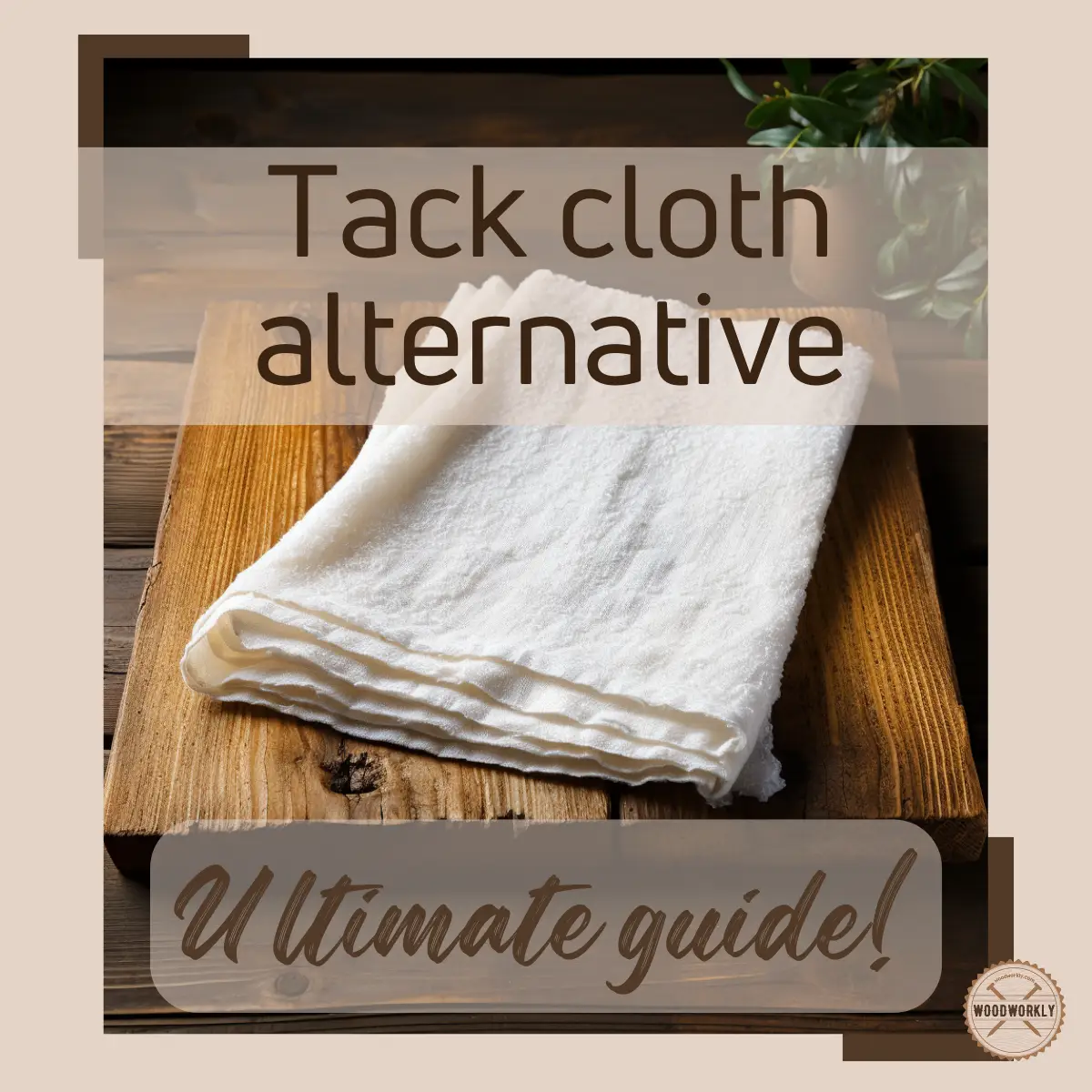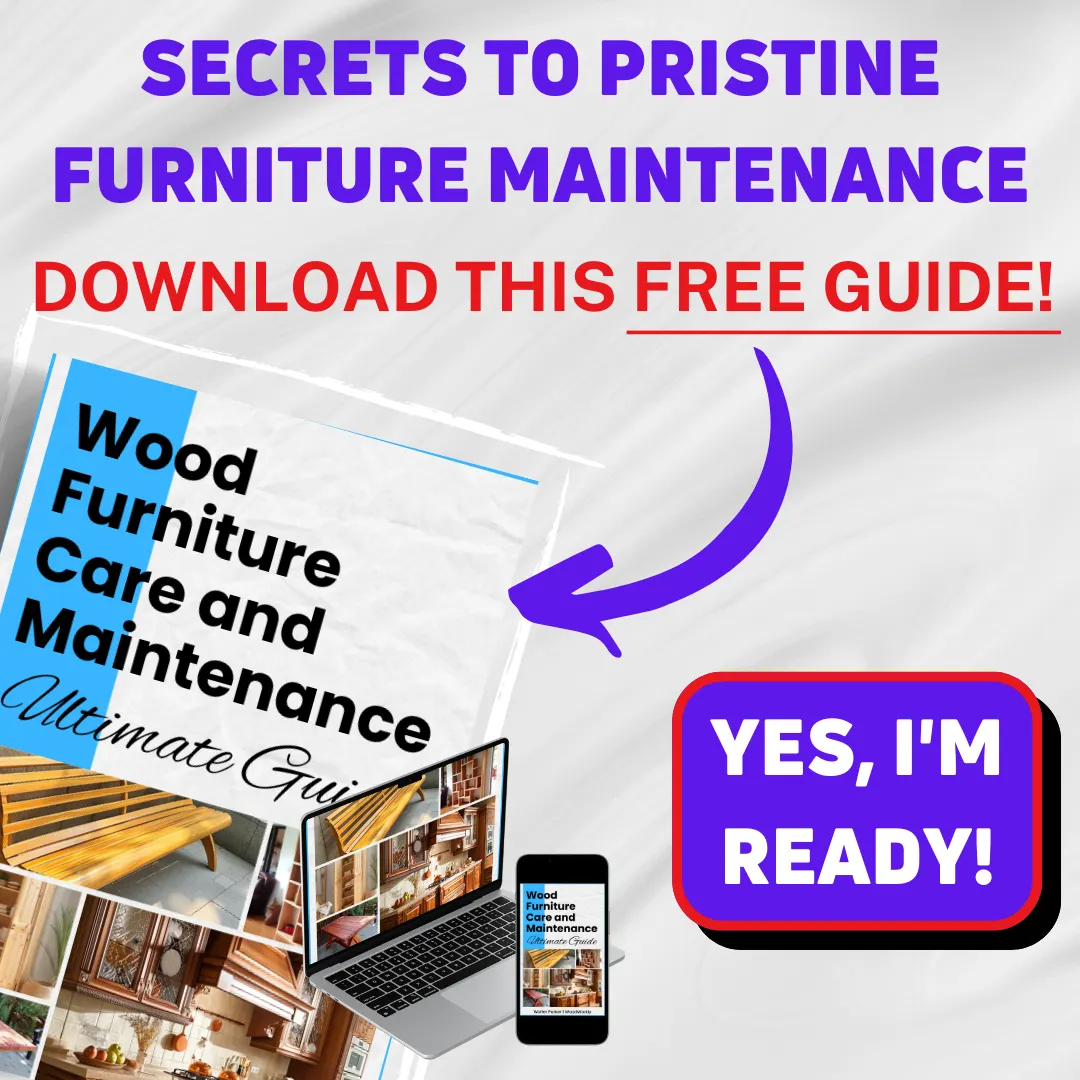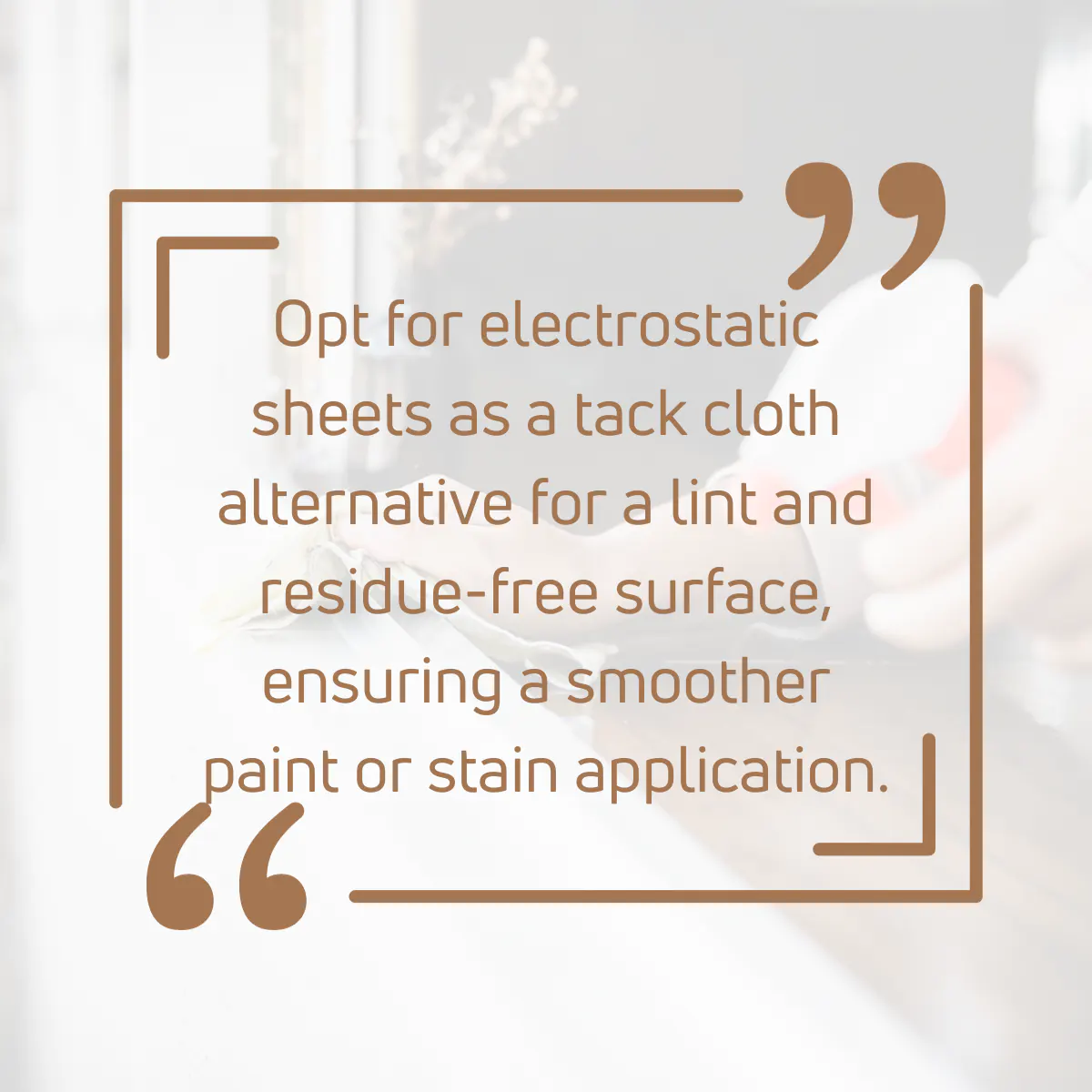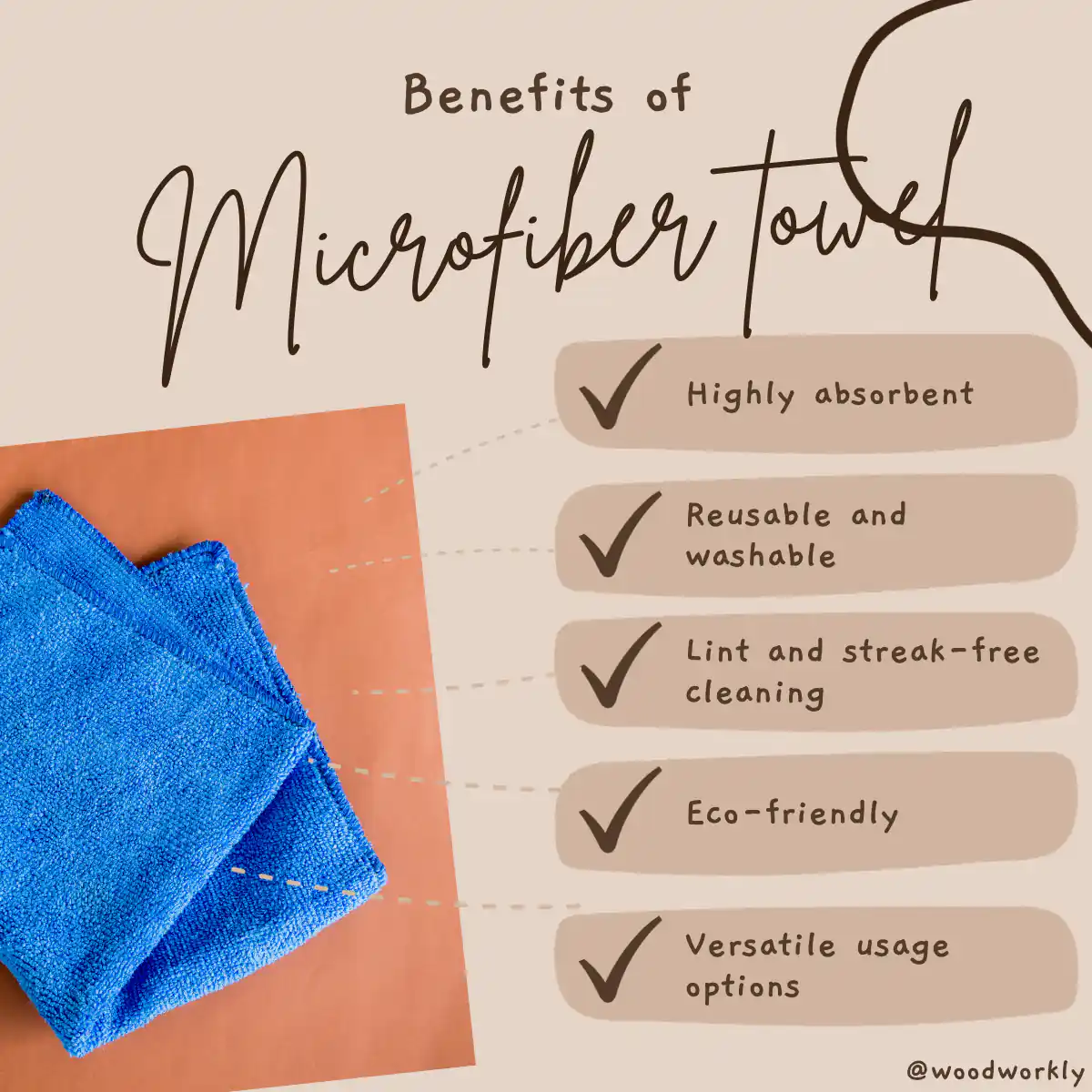Ever struggled with the sticky residue left by tack cloths? Discover efficient alternatives that ensure a flawless, residue-free finish for your projects. Curious? Read on!

When I first came to this field, I used tack cloth to clean the surface of the wood. But when I used it, I had many problems with it because the clothes I used were too old.
So, I was looking for alternatives for tack cloth. Luckily during that time, there was an expert near to my home who had more than 2 decades of experience in woodworking.
I went for him and he suggested some of the best alternatives for tackcloth.
Now with years of experience working with those alternatives, I’m going to tell you which ones are the best tack cloth alternatives you should go with.
So, let’s find, Tack cloth alternative,
Tack cloth alternatives include microfiber towels, electrostatic/Swiffer sheets, damp cloths, naphtha/mineral spirits, and furniture polish. These options are effective for dust removal without leaving a sticky residue, offering a clean surface for painting or staining.
In this article, I’ll explore tack cloth alternatives in detail, how they differ from tack cloth, and help you select the one that suits you most.

Furthermore, I’ll answer some frequently asked questions as well.
So, let’s get started!

What Is a Tack Cloth?
Paint is applied to get the desired finish of the project. For this, the surface to be painted should be free from dust and dirt.
Tack cloth is most used for this. This removes the dirt and dust on the surface well and gives a clean surface.
Tack cloth is made from cheesecloth or a gauze-like material. These clothes are soaked in sticky substances like oil or beeswax.
Tack cloth is soaked with sticky substances, so when you wipe a surface with it, dirt and dust are removed well.
Tack cloth usually comes in larger sizes, but it is possible to buy as you like.

When Should You Use Tack Cloth?
After sanding the surface, the surface must be cleaned by applying a new coat of paint. Otherwise, there will be dirt and dust. Therefore, tack cloth should be used.
Tack cloth can be used for cleaning unfinished furniture windows and doors.
Do not use traditional tack cloth on glass, metal, ceramics, leather, or rough surfaces.
How to Use Tack Cloth?
Now you have the main idea about what is tack clothes and when you should use tack cloth.
So, let’s see now how to use tack cloth.
A few steps must follow this.
1. Removal Of Large Particles
First, use a piece of cloth to remove large dust and dirt particles that are trapped on the surface and corners.
Whole the area should be cleaned well because dust can cause lots of issues.
2. Use Of Gloves
This is not essential. But there is an advantage of putting on gloves, your hands are sticky, and this can be prevented by using gloves.
It is best to put on gloves before using the tack cloth so that this task can be done easily.
3. Cut The Rag Into Small Pieces As Needed
Tack cloth usually comes in large sheets. So, you can buy them as you need.
Our project can be done easily by cutting them into small pieces like sandpaper.
But the scissors become sticky after cutting the tack cloth, so it is better to use old scissors.
4. Do Not Over-Tighten
When using the tack cloth, it should not be pressed. If pressed, some oil or beeswax may remain on the surface while removing dust and dirt.
If oil or beeswax remains on the surface, it will not be able to paint with a good finish.
Therefore, the cloth on the surface should be wiped gently without pressing.
5. Tap The Rags Clog Quickly
When the tack cloth becomes clogged, it does not clean well, so when the tack cloth you are using is clogged, it is advisable to use a new tack rag.
6. Repeat
At every step of the finishing process, we must use a tack cloth to remove dust and dirt. By repeating this process, we can achieve a clean surface.

Tack Cloth Alternative
Tack cloth can easily remove any dust or dirt from the surface of the wood. But tack cloth has several drawbacks.
Because the tack fabric is too sticky, there is a possibility that parts of the surface material will remain.
Therefore, when painting, there will be a paste and it will not be possible to get a good finish.
Being soaked in beeswax or oil, there is also a possibility of reacting with lacquer or varnish paint. Therefore, there is a risk of environmental damage.
Due to these reasons, many people have found alternative methods instead of tack cloth.
For this, several alternative methods are commonly used.
Here are the best tack cloth alternatives,
- Microfiber Towel
- Electrostatic/ Swiffer Sheet
- Damp Cloth
- Naphtha/ Mineral spirits
- Furniture Polish
Now let us discuss alternative uses of tack cloths in detail instead.
1. Microfiber Towel
Microfiber cloth can be considered as a widely used alternative to tack cloth in woodworking projects.

It has several advantages such as not leaving sticky material on the hands or the surface of the wood.
Do not use bleach or highly scented detergents for this.
Microfiber cloth is made up of fine fibers that can hold up to eight times its own weight in water. It can remove dust without using chemicals.

Microfiber is also easier to clean. Shake it well to remove dust, soak it in warm water for 15-20 minutes, then rinse it under running water and let it dry. This makes it easy to use again and again.
2. Electrostatic / Swiffer Sheet
Another alternative to tacking cloth is to use an electrostatic sheet or Swiffer sheet.

Electrostatic sheets impart a negative force that attracts particles to the surface.
This negative charge attracts dust and dirt particles and thoroughly cleans the surface.
These are available in two types, disposable and reusable or washable electrostatic plates.

These washable electrostatic plates retain their negative charge even after washing, so they can attract dust particles with good efficiency.
3. Naphtha/Mineral spirits
As an alternative to tack cloth obtained from the market, tack cloth can be made using naphtha and mineral spirits.

Naphtha and mineral spirits are high-grade cleaning agents that have been used for many years.
This alternative method involves soaking a piece of linen-free cotton cloth with naphtha or mineral spirits.
Naphthalene is a flammable substance used to remove stubborn paint stains and other surfaces.
Therefore, it is important to be careful when using it. Because this liquid evaporates quickly, no chemicals are left behind.
The project should be allowed to dry well in an airy room to speed up evaporation.

Mineral spirits are a solvent like turpentine that is made from petroleum-based compounds. It is a milder solvent than naphthalene.
Read to learn how to use mineral spirits on wood!
4. Furniture Polish
Another option that can be used instead of tack cloth is to use a furniture polishing lint-free cotton cloth.

This cleans the surface thoroughly without leaving any residue on the wood.
An advantage of this is the possibility of repeated use after washing. There are several brands of polish used.

Care should be taken not to purchase a silicone-based spray as it can interfere with the finish.
5. Damp Cloth
Wet cloth is another alternative to tack cloth. This is easily available.

By using this, you can remove the dust and dirt on the surface, but you can also see the shortcomings of this.
It can absorb water that is harmful to the surface of the wood.

How Do You Make Homemade Tackcloth?
If you want tack cloth, you don’t have to buy it. You can easily make it at home. Below are the steps to make it easy.
Materials Required
- Pieces of cotton cloth
- Turpentine
- Varnish
- Water
The procedure of Making Homemade Tack Cloth
- First, cut the cotton fabric into square pieces.
- Then wash the cotton cloth well with water.
- Cotton cloth washed with water should be dried well.
- Dip dry cotton cloths in turpentine to saturate them.
- After the turpentine has dried, pour the varnish on the cotton cloth, making sure to get a uniform yellow colour.
- Now you have an alternative that can be used instead of tack cloth.
- You can use this for your project as you wish.
Is Tack Cloth Necessary?
Yes, it is essential to use a tack cloth when finishing the project and paint or stain it, otherwise, the desired finish will not be achieved.
A tack cloth can remove all the dirt and dust from the surface of the wood, thus providing a clean and smooth surface for painting.
The surface is not suitable for painting when it is not cleaned.
If the surface is dirty, or dusty and paint or stain is applied on it, the finish bonded to the surface instead of the paint or stain will remove the dirt later.
How to Make a Tack Cloth with Mineral Spirits
A tack cloth can be made by saturating a lint-free cloth with mineral spirits.
Materials Required:
- Clean, lint-free fabric
- Mineral spirits
- Water
The Procedure of Making Tack Cloth with Mineral Spirits
- Wash and dry the cloth pieces cut into squares.
- Soak dry pieces of cloth in mineral spirits so that they are saturated.
- Then dry the soaked pieces of cloth well. The drying time may vary depending on the humidity of the environment.
- Once dry, store in a plastic bag to prevent evaporation of the mineral spirits.
Wear gloves when working with mineral spirits. Use in well-ventilated areas. Avoid breathing mineral spirits fumes.

Tack Cloth vs Microfiber
Tack cloths and microfiber cloths are two of the most popular choices most people use to clean surfaces before staining, painting, and varnishing.
There are several differences between the two.
Tack Cloth
- Tack cloth is made from gauze-like fabric that has been treated with an adhesive resin.
- This tack cloth removes dirt and dust from the surface of the project well.
- Tack cloth often can leave a sticky residue on the hands and on the project itself.
- Tack cloth cannot be reused after washing and must be discarded after use.
Microfiber
- Microfiber cloth is made from small synthetic fibers woven together.
- Made of these fibers, it removes dust and dirt well without leaving any sticky residue and gives a good finish.
- Microfiber cloths are more environmentally friendly than tack cloths because they can be washed repeatedly and used multiple times.
That’s it, folks! Now you have a clear ide about tack cloth alternative to select the one that suits you the most and now you know which one you should use instead of tack cloth for woodworking and wood finishing projects.
So, let’s answer some frequently asked questions.
FAQs
What are some common alternatives to tack cloth?
Alternatives to tack cloth include microfiber towels, electrostatic or Swiffer sheets, damp cloths, naphtha/mineral spirits, and furniture polish. These options effectively remove dust and debris without the residue or potential reactions associated with traditional tack cloths.
Is a microfiber towel a good replacement for tack cloth?
Yes, microfiber towels are a popular tack cloth alternative as they are effective in removing dust, reusable, and don’t leave a sticky residue. They’re also easy to clean and environmentally friendly due to their reusability.
Can I use a damp cloth instead of a tack cloth?
A damp cloth can be used in a pinch but may not be as effective as other alternatives. It might push dirt deeper into the surface and the moisture can be detrimental to wooden surfaces.
How do naphtha or mineral spirits compare to tack cloths for cleaning surfaces?
Naphtha and mineral spirits are effective cleaners that can be used to make DIY tack cloths. They offer thorough cleaning without leaving residue and evaporate quickly, preventing any chemical remnants on the surface.
Are Swiffer or electrostatic sheets effective as a tack cloth alternative?
Yes, electrostatic sheets are effective in attracting and holding dust particles due to their negatively charged surface. They come in both disposable and washable varieties, making them a convenient option for surface cleaning.
Is it necessary to use a tack cloth before painting or staining?
While it’s common to use a tack cloth to remove dust and debris before painting or staining, alternatives like microfiber cloths can achieve a clean, smooth surface without the residue tack cloths sometimes leave behind.
Can a tack cloth be washed and reused?
No, traditional tack cloths are not meant to be washed and reused. They become filled with dust and debris and lose their effectiveness after one use.
How do I make my own tack cloth?
DIY tack cloths can be made by soaking a lint-free cotton cloth in substances like turpentine or mineral spirits and allowing it to dry. It offers a cost-effective and efficient alternative for surface cleaning.
Are there any eco-friendly options to replace traditional tack cloths?
Microfiber cloths are an eco-friendly alternative as they are washable and reusable, reducing waste. They effectively remove dust and dirt without the need for chemicals or disposable materials.
Can tack cloth residue affect the paint finish?
Yes, the sticky residue left by tack cloths can sometimes affect the final paint finish. It can react with the paint or leave imperfections, which is why many prefer residue-free alternatives like microfiber cloths.
Did I cover all you wanted to know about: Tack Cloth Alternative
In this article, I’ve deeply discussed the tack cloth alternative with their pros, cons, and uses and I compared tack cloth with its alternatives to make your selection process a lot easier.
Best tack cloth alternatives are microfiber towels, electrostatic or swiffer sheets, damp cloth, naphtha/mineral spirits, and furniture polish.
Furthermore, I’ve answered some frequently asked questions as well.
Hope you’ve learned all you wanted to learn about tack cloth alternative with uses and applications with expert tips.
Now you don’t need to worry about not having a tack cloth. Select the alternative that suits you the based on the given list and achieve promising results like a pro!